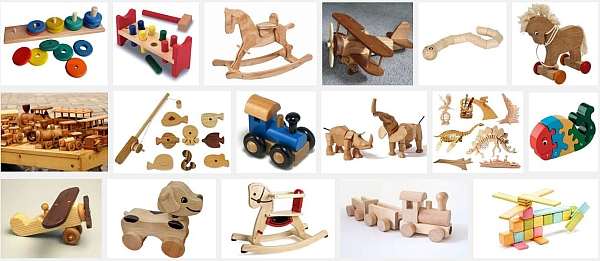Make and sell toy cars, wagons, wooden puzzle and hobby horses. Retail them at flea markets, fairs, through national ads, direct from your shop or yard and/or wholesale them to stores or catalog sales companies.

Wooden toys have a special appeal that most other types of toys do not– nostalgia and parent confidence. Parents remember the wooden toys they had as children lasted a long time and that they were safe. Wooden toys like hobby horses or stick horses are so old, they are “new”!
For the past few years, wooden items have become more and more scarce as they have been replaced by plastic and wood filled plastics that can be molded. Many items are advertised these days as “genuine wood” to inform the buyer they are nor plastic or laminated sawdust, and infer that they are therefore worth more.
The overall result is that an item made of “genuine wood” is now considered more valuable than the substitutes that just a few years ago were considered an “improvement” over wood.
In the wooden toy business, you have the option of making variety of things or specializing in one item or series of items.
You also have the luxury of being able to use what other industries would call scraps — because not many of your toys will require 8, 6 or even four foot pieces of wood.
This means that you can use materials that others can’t — and that if you can locate a good source, your materials should be half or less of the going rate. As a result, you will be able to offer finished toys of good quality wood at excellent prices and still make a very nice profit.
This type of business will appeal to the wood enthusiast, or anyone who enjoys shop work; the variety of possible toy products is endless — limited only by the toy maker’s imagination and facilities. Plus, you can incorporate other types of materials as well, such as resin. By exploring ideas for wood and resin projects, you can level up the toys you create and make the most out of the materials you have.
If you specialize in larger items such as hobby horses, one well-placed ad for genuine, old-fashioned hardwood horses could keep you busy!
The only “secret” to this business is to have a plan for getting your materials at a good price, a procedure to fabricate and finish the toys efficiently and professionally, and effective means of letting the right prospective customers know where they can be found and how much they cost.
Most wooden toy makers limit their output to models they can build with tools and equipment on hand. They set up a procedure, as close to assembly line as possible to allow high quality items to be produced efficiently: jigs for cutting, clamps for gluing, patterns for drilling, stencils for painting — with designated areas for operations like sanding or painting that require them to be separated.
Although the finished items are all made by hand, there is no need to completely finish one item before starting on the next — it is much “smarter” to cut out two dozen horse heads at once; to sand them all while the area is set up for that operation, and to give them all their first coat of paint at the same time.. The items are still hand made, only a lot more efficiently.
The bottom line is that quality is just as high (perhaps even higher as you perfect each step), but the price is lower because you can produce them cheaper.
One inexpensive way to advertise is to rent a display window in a store (even a vacant store — see the real estate agent about renting just the window until the store is leased).
Set up a nice looking display of your products –several models, a variety of items (or your “pride and joy”) in an attractive display – one that is calculated to interest children as a toy, as well as the parents as a good investment.
Tip: “Eye level” for a child is 3 to 4 feet, so place items you want to see at their level!
Put price tags on the items or a placard (about 8 x 10) in or near the items, along with a couple of lines about their quality and, of course, where they can be purchased.
If you are willing to make alterations, indicate that custom items are available (but leave the price open until you find out what they have in mind).
Plan your production schedule to peak about 30 days before the holidays — seasonal sales you lose because you ran out of items sell are GONE!
In the beginning, you will probably want to try several different products — and procedures. You need to learn which things you can make best and which ones will sell best.
Once you have settled on a line of products (if you do), it would be wise to gear your “assembly line” to those products.
Use a piece of tin or masonite for a cutout pattern; holes in it to mark places to drill. Work out a production schedule for steps that take time, such as glue setting and paint drying — where you take an item from the clamps, sand it lightly, lay it out for the painting phase and immediately place another item (or sets of items) the available glue clamps.
If you glue, setting time is one hour (temperature regulation may speed this step) and you have 5 sets of glue clamps, you can set aside 5 or 10 minutes per hour for this phase to produce 5 items per hour or 40 per day (the last set is left overnight to be changed first thing in the morning).
As you progress in your wooden toy business you will discover more and more “shortcuts”– that produce the same quality (or even better) at a lower cost. You will also learn of other items that are in demand and will make more decisions on whether to expand or add new products.
Wooden toys can be sold retail through ads, displays, and by using a little extra imagination.
For example, show a child playing with your toy in your ad (to help “plant” the idea that your toys are fun to play with). Plan different ways to “push” your line — give prizes at community affairs (raffle, children’s competitions), try cable TV ads and the local newspaper.
Use a good camera to take black & white photos and have the newspaper make “cuts” of some of your best efforts to put in ads and brochures. When the market warrants, add color brochures with illustrations and little write-ups of your toys.
Perhaps some of them are authentic copies of antiques, or can be associated with interesting stories or history. Don’t hesitate to experiment with different wood combinations and patterns.
For example, two plywood with opposing grains for strength and effect; tongue & groove glued larger pieces; checkerboard patterns (like parquet floor pieces) or anything else you can think of.
Wholesaling brings in less revenue per item but eliminates much of the cost of advertising and time needed for dealing with potential buyers of one or two items at a time (you may be able to make much more turning out toys than selling them).
Here are three proven methods for wholesaling are:
1. Store sales, Take samples and price lists to retail stores in your area and ask them to order. A variation is to mail out price lists and brochures to stores that carry similar merchandise. In this case, write a “cover” letter of 1 – 2 pages on good quality letterhead paper. Describe your products briefly (stress their quality) and their availability. Include a price list and an ORDER FORM. For stores in your area, follow up this first contact with a personal visit, phone call or another letter 2 weeks later!
2. Catalog sales. List your products with an existing catalog sales firm (printing your own is expensive and should be tried only when you are experienced). the procedure is similar to mail sales to stores (above), but you also need to include your charges for packaging and shipping of a single item because the mail catalog store can either buy your products outright or have you drop-ship them as orders come in.
3. Fair sales. arrange for a booth at trade shows, large flea markets and community fairs. Take a good selection of your merchandise, business cards, brochures, and order forms and set up an attractive display.. Although the objective will vary with the type of activity. the general idea is to retail, make contacts, gain recognition, and to take wholesale orders.
Be especially watchful for ways to profitably use every scrap of material and reduce the amount you spend for supplies.
Make little toys from pieces left over from big ones, even if it means modifying a pattern or designing a special toy so it can be fabricated mostly from materials that would otherwise be wasted. Using these materials efficiently is the purest form of profit!
Then, calculate your best prices on paint, sandpaper, wood and even tools and supplies. It may be that buying glue in 5 gallon cans will save you a good deal — unless there is a spoilage problem. In this department, the most expensive thing you can do is to keep buying from the same source without constantly checking — and figuring how to get more for your money.
One source for fresh ideas would be subscribing to a couple of good trade magazines.
One of the more obvious potential problem area to watch out for is overstocking items that don’t sell.
The cause of this problem is invariably personal taste — although poor sales techniques and/or shoddy work can also be contributors. Just remember that before you invest too heavily in any one product, do as the professionals do — test market it (see how it sells).
Just because you like something is NOT a good reason to make up 10,000 of them (remember the Edsel? — but if your customers like them — that’s different! If your problem is shoddy work, the CHEAPEST thing to do is get rid of the problem — wholesale them to an outlet (burn them if necessary), but don’t allow them to spoil your reputation and confidence.
Finally, if they aren’t selling, alter your method of advertising. If that helps, work on that aspect until you find the winning combination!







Thanks for the good guide. The production process is not a simple thing. You need to know a lot of nuances as well as sales. If you want to improve your sales there is nothing better than a properly designed website. Check out the examples of development:
https://blog.codeharbor.dev/2022/11/16/the-process-of-developing-e-commerce-website-part-1/
Data encoder – Apply for online work
You can earn while enjoying time with your family and love ones.
for more details, kindly visit http://www.unemployedpinoys.com/
to get started., Email me at besbremisana@yahoo.com